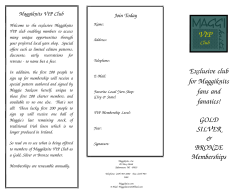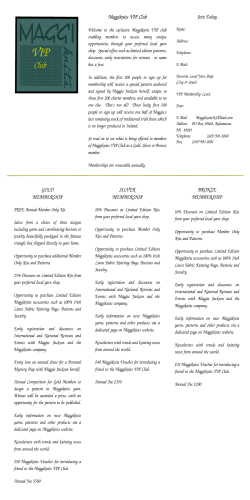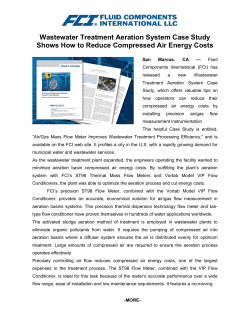
HOW TO IDENTIFY A HIGH QUALITY VIP
HOW TO IDENTIFY A HIGH QUALITY VIP - Methods and techniques to guarantee high quality in production and application Gregor Erbenich Global Marketing Manager Porextherm Dämmstoffe GmbH Heisinger Str. 8 87437 Kempten Germany Phone: +49 831 57 53 60 Fax: +49 831 57 53 63 E-mail: Gregor.erbenich@porextherm.com Theme 1: Materials and technological developments Keywords: quality, test equipment, approvals, quality label, VIP-protection Abstract: Quality of a Vacuum Insulation Panel is hardly to recognize for customers/users. Just a view obvious indicator, like stability of the panel or surface appearance of the foil bag, can provide serious information about a good or failed panel. VIPs with micro perforations can hardly be detected by these indicators or other simple tests. Also available “sensors” that can be used on the construction site are not accurate enough to detect these micro leakages. Keeping in mind and respecting, that VIPs are somehow binary products, the quality can only be generated on the production site and - perhaps - be re-inspected on the construction site, if suitable equipment is available. In order to provide confidence in quality and longevity of VIPs, standardized and controlled state of the art production processes, raw-materials and tests methods need to be fixed and consequently guaranteed by a quality label, that can be easily recognized by the customers/users. The presentation will give brief information about available quality control equipment, including an evaluation of advantages, disadvantages and practicability of each method. Besides this, information is given about building authorities’ approvals, related external quality control and the exceeding quality- and test criteria, fixed by the RAL quality label for Vacuum Insulation Panels used in building and construction applications. Finally, the presentation will show various available kinds of coverage and systems that should improve VIP-protection during handling at the site. Paper 1. Introduction In the daily business, every VIP-producer is confronted by its customers with the same, always repeating questions on panel sizes, lifetime expectation, prices, approvals and “how can I identify the quality of a VIP”. In fact, there is just one simple, understandable and everywhere available method available, which is just the visual and haptic control of a panel. It is easy to teach and to understand for every customer, that the surface of a failed panel is not wrinkled but plane. It is also easy to detect, that a failed VIP is not somehow rigid but soft. However, this just gives binary information to the customer whether the VIP is good or totaly failed. All other methods such as measuring devices, sensors etc. are very often not available, too expansive and usually do give information about just one criteria, such as thermal conductivity or internal pressure. In order to get accurate information about the actual quality but also about performance over the lifetime of a panel, more criteria need to be checked. Based on the most common measurement devices for thermal conductivity and internal pressure, the measurements done are usually just an observation at a specific point of time. In order to recognize a trend or to make an estimation for the lifetime expectation, at least two or three measurements need to be done on the same specimen under the same conditions. All other methods assume that in case a certain threshold value is not exceeded, the VIP will work properly. Keeping in mind that measured values are sometimes influenced or overlapped by different criteria it is hardly to decide, if a measurement can be serious without an in house control of these criteria. Whether this can be done in principal and especially at the customer site, should be verified and critically analyzed in this paper. 2. What determines the quality of a VIP In principal, the customers need is a defined insulation value over lifetime in his certain application. Quality in sense of thermal performance over lifetime of a VIP is determined by various parameters. Depending on the customer expectations some of these criteria might be of less importance, but e.g. in case of building and construction applications, the requirements are so demanding that every influencing factor should be respected and managed. Main criteria to determine the quality of a VIP are as following: ⇒ Raw materials e.g. quality of fumed silica (porosity, surface etc.), open cell foam (pore size etc.) ⇒ Moisture content of raw materials ⇒ Humidity in production and raw material storage facilities ⇒ Barrier properties ⇒ Quality of sealing ⇒ Vacuum level ⇒ Density of core The question to answer is, who takes care and who is able to do necessary quality control at a certain production step. We assume, that it is obvious, that most of the customers are not able/prepared to check most of the above mentioned criteria. Due to this fact, they have to rely on the quality philosophy of the supplier or already installed quality control systems, external control systems etc. Consequently it is to clarify, what kind of quality control can seriously be done on the customer site. ⇒ Visual check ⇒ Haptics check ⇒ Dimension check ⇒ Internal pressure ? ⇒ Thermal conductivity ? For sure dimensions, visual appearance as well as haptics can be checked at every customer site. But, what kinds of measurement devices are available and which of them are feasible, reliable and cost wise reasonable? In the following we will introduce the different existing test methods for thermal conductivity and internal pressure. 3. Overview of test methods for internal pressure and thermal conductivity In the following you can find a technical overview of test methods for internal pressure and thermal conductivity without any kind of assessment. Method Measuring procedure direct Guarded hot plate method Hot box method What is required to determine thermal conductivity? indirect Amount of heat Q X Heat Flow method Measured parameter X X Temperature difference ∆T Calibration standard Heat transfer coefficient U Insertion of solid bodies method X Heat flow Calibration (λ vs. p for membrane and λ vs. p for VIP) Measurement effusivity X Thermal effusivity E Different parameters Foil lift-off method X Interior gas pressure p Laser distance measurement Calibration curve λ vs. p for VIP Gas pressure sensor X Interior gas pressure p Calibration curve λ vs. p for VIP Gas volume sensor X Gas volume Oxidisable surface (only good / bad verdict possible) Heat Flow comparison method X Heat flow Reference VIPs for calibration curve In the following we will concentrate on the most common “commercially available” systems, describe their function, discuss advantages and disadvantages and evaluate their feasibility (also under cost aspects) for the customer. 3.1. Guarded hot plate method One- and two-plate measuring devices are used to calculate the thermal conductivity from the experimentally determined one-dimensional heat flow, the sample thickness and the measured temperature difference across the sample. A metal plate in the centre is heated to a controlled temperature. In the two-plate device, it is bordered by identical samples of known thickness on each side. The other surface of the samples is in contact with thermally controlled heat sinks. The heating power is regulated to maintain constant temperatures. The heating power in the hot plate dissipates symmetrically through both samples into the outer plates. To ensure one-dimensional heat flow, the central hot plate has concentric guard rings maintained at the same temperature as the central plate. In the single plate device, a combination of insulating material and a guard plate replaces the second sample. The guard plate is regulated such that the hot plate and the guard plate have the same temperature. The measurements with the plate instruments are absolute measurements that do not need calibration. Figures 1 & 2 show schematics of guarded one- and two-plate devices. Fig. 1: Schematic of a set-up of a with the guarded one-plate device Fig. 2: Schematic of a set-up of a with the guarded two-plate device Advantages of this system: ⇒ very accurate/direct measurement of thermal conductivity (all parameters are known or determined automatically) ⇒ nearly no limitation of specimen size and thickness (depending on measurement apparatus, width of up to 760 mm are possible, length lo limits) Disadvantages of this system: ⇒ very slow, ~ 1 – 1,5 h per measurement ⇒ not mobile ⇒ very expansive 3.2 Gas pressure measurement on VIPs using the foil lift-off method The foil lift-off method is a pressure measuring method, developed specifically for VIPs with flexible cover that does not require integrated sensors or manipulation the panels. In this method, the vacuum insulated panel (or, with the suction cup method, part of its surface) is placed in a chamber. To perform the measurement, the pressure in this chamber is lowered by evacuation until the gas pressure in the VIP is sufficient to balloon the foil cover into the chamber. This effect can be accurately observed if the gas pressure in the vacuum insulated panel is slightly above ambient. The chamber pressure is measured and foil lift-off is measured by a laser distance meter or a light barrier. To detect the foil lift-off, the VIP surface is covered with a diffuse reflective adhesive tape in the area of the laser measuring points. The initial lifting of the foil is never recorded, since the first release process may clearly differ from the subsequent processes, which can be explained by effective adhesion of the foil to the core under the constant surface pressure of 1 bar or 10 t/m2. Fig. 3: Principle of the foil lift-off method [Simmler 2007] Laser distance, mm The data is analysed by graphing the distance measurements against the chamber pressure. In the transition zone, i.e. the zone where the foil starts to lift off, the measured values are approximated by two regression lines, the intersection of which is recorded. The result of the test is the average of at least three positions (laser measuring points) and three repeat measurements. The internal pressure is normally specified for the temperature in the laboratory, i.e. 20°C to 25°C. Chamber pressure, mbar Fig. 4: Pressure measurement based on the intersection of two regression lines. [Simmler 2007] As already mentioned, the suction cup measurement is an alternative for measurements in a vacuum chamber. The decisive difference between the two is that the complete panel is subjected to low pressure with the vacuum chamber measurement whilst, with the suction cup measurement, only part of the VIP surface is involved. The results of the two measurement methods may differ. The reason is that the VIP volume can expand in the vacuum chamber, increasing the available volume for the gas in the VIP and resulting in an erroneous lower measured gas pressure. Assuming that the temperature T in the vacuum chamber does not change during the measurement (= isothermal change in state), the following applies to the gas in the VIP acc. to the laws of BOYLE and MARIOTTE: p1 ⋅ V1 = p2 ⋅ V2 = konst. (7) where p1 V1 p2 V2 … … … … gas pressure in the VIP outside the vacuum chamber volume of the VIP outside the vacuum chamber gas pressure in the VIP during the vacuum chamber measurement volume in the VIP during the vacuum chamber measurement Since, due to the “relaxation effect” in the vacuum insulation panels, V2 > V1 is valid, therefore p2 < p1 follows as per equation (7). The severity of the “relaxation effect” is materially influenced by the density of the supporting core, i.e. a denser supporting core reduces the VIP volume change and as such also the gas pressure measurement error. With the suction cup measurement method, only a small region of the VIP surface is involved in determining the gas pressure, with the result that the measured gas pressure is independent of the volume change and may be disregarded. Advantages of this system: ⇒ very accurate measurement of internal pressure ⇒ limitation of specimen size and thickness only depends on inner dimensions of vacuum chamber or diameter of suction cup ⇒ for a good / bad decision regarding allowed internal pressure less than a minute is needed Disadvantages of this system: ⇒ reasonable fast ~ 2 – 5 min (in vacuum chamber) per measurement ⇒ not mobile. „mobile version“ is not really mobile. Double check necessary due to adhesion of barrier film to core ⇒ reasonable expansive ⇒ for 100% testing, vacuum chamber version is too slow or chamber is blocked for production 3.3 Insertion of solid bodies to determine the internal gas pressure of a VIP Gas pressure and thermal conductivity are correlated in VIPs. The thermal conductivity of gas in porous materials, as in supporting cores of vacuum insulation panels, is determined primarily by pore size and the type of gas and gas pressure [Kaganer 1969]. The relationship is as follows: λGas = λGas , 0 2 ⋅ β ⋅ lGas 1+ lPore = λGas , 0 1+ p1 / 2 p (1) where lGas lPore p1/2 … … … … … … p … λGas λGas, 0 β gas thermal conductivity as a fraction of the total thermal conductivity of the free gas parameter depending on wall and gas type mean free path of the gas pore diameter the characteristic, pore size dependent, half-value pressure (= the pressure at which the thermal conductivity of the air in the material is 50% of that of still air (0.026 W·m-1·K-1)) gas pressure in the VIP In the case of a VIP in perfect order, lGas >> lPore is valid, whereby the value for λGas in (1) approaches 0 and the contribution of the thermal conductivity of the gas to the total thermal conductivity of the vacuum insulation panels becomes negligible. Determining the increase in gas pressure from the increase in thermal conductivity of the supporting core material therefore involves complex measurements and long waiting periods between measurements. To calculate the gas pressure in the VIP from a basic thermal conductivity measurement, the thermal conductivity of a material with the greatest possible variation of this parameter as a function of gas pressure, over the relevant pressure interval, must be measured. This is the case when the characteristic half-value pressure and the gas pressure in the operational vacuum insulation panels are approximate equal. For equation (1) the ideal case, i.e. p1/2 = p, means that 2 ⋅ β ⋅ lGas =1 lPore (2) i.e. lPore = 2 ⋅ β ⋅ lGas. If, equipped with this insight, the characteristic thermal conductivity vs. gas pressure curve is now examined for different micro porous and open-celled materials, it becomes clear that a filamentary substance is best suited as material for vacuum insulation panels with micro porous support material (1 – 5) mbar gas pressure). Gas type: N2 (dry) Glass fibre PU foam PS foam Precip. silica Fumed silica 13 mW/(m×K) ∆ 8,7 mW/(m×K) 5 Gas pressure Fig. 5: Thermal conductivity vs. gas pressure – suitable material for determining the gas pressure in a vacuum insulation panel There is a system which is based on this measurement principle, where a small metal plate is inserted as the vacuum insulation panel is manufactured; this metal plate is separated from the cover foil by a thin material, i.e. a thin membrane [Caps 2003]. In this case, the membrane is the large-pored foreign body, compared to the micro porous supporting core material, with a thermal conductivity more pressure-dependant than that of the supporting core material. The heat flow measurement signal is proportional to the thermal conductivity of the foreign body. By inserting the metal plate, a steady measurement signal is achieved for a limited period. The gas pressure is calculated using a prior calibration for the specific membrane. The measuring signal is proportional to the temperature difference between the sensor and the metal plate before the measurement. The temperature of the metal plate must therefore be determined prior to the measurement, e.g. by measuring the ambient temperature. The thermal conductivity of the membrane can alternatively be found from the slope of the logarithmic graph of the measuring signal. The resolution of the method is determined mainly by the relationship between the thermal conductivity of the membrane and gas pressure. The largest thermal conductivity variation in the desired pressure range, and thus the best resolution, is achieved, as already mentioned, if the half-value pressure p1/2 is approximately equal to the gas pressure p in the vacuum insulation panel, i.e. p1/2 ≈ p. By selecting a suitable membrane, a measuring range in which the method is as sensitive as possible can therefore be accommodated. Since the heat flow from the sensor is not only via the metal plate in the VIP but also laterally via the VIP foil cover, a separate calibration is required for each foil type if different cover foils are used. With this measuring method it must be strictly ensured that the measurement conditions correspond with the calibration conditions, to avoid significant measurement errors. It is well known that the VIPs thermal conductivity depends on the moisture content of the core material. The moisture content also affects the thermal conductivity of the membrane. Apart from the nitrogen and oxygen “dry gases”, it is mainly water vapour that penetrates into the VIPs. If the VIPs contain moisture, either a higher or lower thermal conductivity of the membrane may result. At normal pressure, the thermal conductivity of water vapour is approx. 30 % lower than that of air – which should reduce the heat flow. Water deposited on the filaments and in the cover foil and evaporating when heated by the sensor, on the other hand, increases the heat flow and increases the gas pressure measurement values. If the water accumulates on the contact points of the filaments or powder parts, however, this will increase the heat transmitted through the solid frame. [Büttner et al. 2005] An exemplary schematic test set-up with such a system is as follows: thermal screen enclosure temperature sensor, heating sensor probe barrier film porous intermediate layer metal disc core material barrier film Fig. 6: Schematic diagram of an exemplary test set-up with such a system for the insertion of solid bodies method [va-Q-tec AG 2003] Advantages of this system: ⇒ fast measurement ⇒ very accurate measurement of internal pressure under defined conditions! ⇒ no limitation of specimen size and thickness ⇒ comparably cheap Disadvantages of this system: ⇒ defined conditions for measurement absolutely necessary ⇒ calibration curves necessary for calculate thermal conductivity value. ⇒ not commercial available, due to patent situation ⇒ not standardized 4 Résumé Good, sensitive and reliable working methods and equipment are available, but either to slow, to expansive, to sensitive (against temperature differences etc.). Faster methods/equipment are too sensitive (leading to an incorrect measurement) and are partially not free available. 5 What can be done 5.1 Quality certification In order to guarantee high quality from the beginning on, raw materials, production process, storage and logistics needs to be managed according to approved industry standards like ISO 9001. Beside this an external quality control, as required in connection with e.g. the DIBT approval should be mandatory. In addition, a quality label like GSH – VIP quality label would be desirable, as the defined requirements exceed the already compulsory tests of DIBT. 5.2 Panel protection As a high portion of risk to damage a VIP is existing, during the handling and processing at the customers site, a protection of the panel with certain protection layers is helpful. Protection layers might be various kinds of rigid or soft sheets or the panel could be covered completely with foams, fiber or other materials. Due to the relatively adhesion friendly surface, VIPs can be covered with a lot of materials, depending on the demands, defined by the customer and application. 5.3 Customer training Besides all measurement devices, quality control systems, labels and panel protection layers, a VIP is still a product that is sensitive and in need of explanation. An accurate and detailed product training to the customer is therefore essential. 6. Conclusion As we have shown, up to now, there is no system available that can easily, accurately and reliable detect and guarantee, that a VIP will work properly over its lifetime. Available devices that are accurate and reliable enough are very expansive and not mobile. Therefore these systems are not feasible for use at the customer site. In order to determine the quality seriously a lot of measurements need to be done. Besides this, all these measurements just control a quality level that is created in and during production of the VIP. Therefore, the production process is the crucial factor for the quality of a VIP. In order to achieve the highest quality level, a geared bundle of activities and control mechanism are necessary to guarantee that a high quality panel will arrive at the customer site. Only producers that are able and willing to follow and implement all that systems can guarantee a high quality VIP to their customers. Even so, a VIP is and remains for the next time a sensitive product. All quality testing, sensors or what so ever will not help to save the panel against destruction. Intelligent protection solutions will help to reduce this risk to a very low level. However, the handling still carries certain risk and needs informed and trained customers. If all actions are taken and advices are respected on the certain levels of production and use, the risk of a failure is very low. However, the demand for an easy to handle, cheap and very accurate measuring device or sensor is still vacant. As the VIP market is still growing, even in times of world wide economy crisis, perhaps the potential will be recognized being big enough to develop such a system. The market would be pleased. [Simmler 2007] Innendruckmessverfahren für Vakuumisolationspaneele, EMPA Abteilung Bautechnologien, CH-8600 Dübendorf, 19. April 2007 [Kaganer 1969] Thermal Insulation in Cryogenic Translation, Jerusalem, 1969 [Caps 2003] Vorrichtung und Verfahren zur Messung des Gasdruckes in evakuierten Dämmplatten, Deutsches Patent DE 10215213 C1, September 2003 [Büttner et al 2005] Messverfahren zur Qualitätskontrolle bei Vakuumisolationspaneelen, VIPBau: 2. Fachtagung „Erfahrungen aus der Praxis“ am 16. / 17. Juni 2005 in Wismar (Germany) [va-Q-tec AG 2003] Messung des Gasdruckes in evakuierten Dämmplatten mit va-Q-check, va-Qtec AG, 28. Januar 2003 Engineering, Program for Scientific
© Copyright 2025












